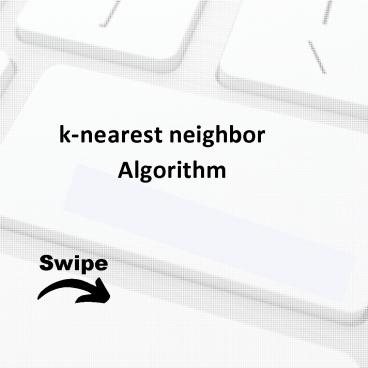K nearest neighbor algorithm - PowerPoint PPT Presentation
Title:
K nearest neighbor algorithm
Description:
This presentation guide you through k-nearest neighbor, k-nearest neighbor Algorithm, How does the KNN algorithm work?, How does the KNN algorithm work?, How do we choose the factor K?, How do we choose the factor K? and Implementation of kNN in R. For more topics stay tuned with Learnbay. – PowerPoint PPT presentation
Number of Views:1025
Title: K nearest neighbor algorithm
1
k-nearest neighbor Algorithm
Swipe
2
k-nearest neighbor
KNN stands for K Nearest Neighbor and is one of
the most basic machine learning algorithms. The
number K in KNN stands for the number of nearest
neighbours we utilised to categorise fresh data
points.
3
k-nearest neighbor Algorithm
KNN can be used for both classification and
regression predictive problems. However, it is
more widely used in classification problems in
the industry. To evaluate any technique we
generally look at 3 important aspects Ease to
interpret output. Calculation time. Predictive
Power.
4
How does the KNN algorithm work?
Lets take a simple case to understand this
algorithm. Following is a spread of red circles
(RC) and green squares (GS)
You intend to find out the class of the blue star
(BS). BS can either be RC or GS and nothing
else. The K is KNN algorithm is the nearest
neighbor we wish to take the vote from. Lets
say K 3. Hence, we will now make a circle with
BS as the center just as big as to enclose only
three datapoints on the plane.
5
How does the KNN algorithm work?
Refer to the following diagram for more details
The three closest points to BS is all RC. Hence,
with a good confidence level, we can say that
the BS should belong to the class RC. Here, the
choice became very obvious as all three votes
from the closest neighbor went to RC. The choice
of the parameter K is very crucial in this
algorithm. Next, we will understand what are the
factors to be considered to conclude the best K.
6
How do we choose the factor K?
First let us try to understand what exactly does
K influence in the algorithm. If we see the
last example, given that all the 6 training
observation remain constant, with a given K
value we can make boundaries of each
class. These boundaries will segregate RC from
GS. In the same way, lets try to see the effect
of value K on the class boundaries. The
following are the different boundaries
separating the two classes with different values
of K.
7
How do we choose the factor K?
If you watch carefully, you can see that the
boundary becomes smoother with increasing value
of K. With K increasing to infinity it finally
becomes all blue or all red depending on the
total majority.
8
Implementation of kNN in R
- Step 1 Importing the data
- Step 2 Checking the data and calculating the
data summary - Step 3 Splitting the Data
- Step 4 Calculating the Euclidean Distance Step
5 Writing the function to predict kNN Step 6
Calculating the label(Name) for K1
9
Topics for next Post
Neural Networks Similarity learning Stay Tuned
with































